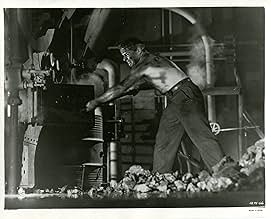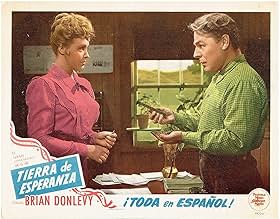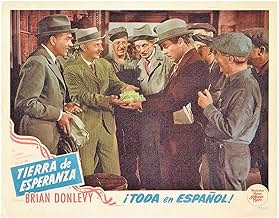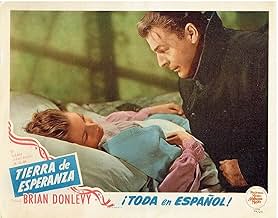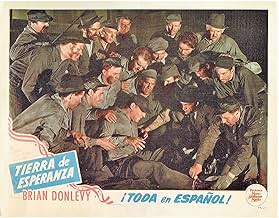CALIFICACIÓN DE IMDb
6.7/10
640
TU CALIFICACIÓN
Stefan Dangos emigra a Estados Unidos y se abre camino desde las minas de hierro y las acerías hasta convertirse en una gran historia de éxito estadounidense como industrial.Stefan Dangos emigra a Estados Unidos y se abre camino desde las minas de hierro y las acerías hasta convertirse en una gran historia de éxito estadounidense como industrial.Stefan Dangos emigra a Estados Unidos y se abre camino desde las minas de hierro y las acerías hasta convertirse en una gran historia de éxito estadounidense como industrial.
- Dirección
- Guionistas
- Elenco
- Premios
- 2 premios ganados en total
Stephen McNally
- Teddy Roosevelt Dangos
- (as Horace McNally)
- …
Ernie Adams
- Man and Dog Act
- (sin créditos)
Erville Alderson
- Olson - Detroit Auto Works Technician
- (sin créditos)
Fred Aldrich
- Assembly Line Worker
- (sin créditos)
Axel Anderson
- Immigrant
- (sin créditos)
King Baggot
- Graduation Ceremony Attendee
- (sin créditos)
Charles Bates
- Teddy Roosevelt Dangos - Age 8
- (sin créditos)
Barbara Bedford
- Hospitable Farm Woman
- (sin créditos)
Arthur Belasco
- Drowsy Miner
- (sin créditos)
Leon Belasco
- Cigar Store Proprietor
- (sin créditos)
Art Berry Sr.
- Customs Man
- (sin créditos)
Anna Marie Biggs
- Girl Soprano
- (sin créditos)
Opiniones destacadas
I saw this movie as a kid of 10 in Port Arthur, Texas, which had four theaters in a four block area. I don't remember all the details, but it was definitely a feel-good film. The protagonist was an Eastern European immigrant whose name was long and hard to pronounce, so he was re-christened Steve Dangos. Steve first got a job iron ore in an "op'm pit". Being bright and ambitious, he later became an automobile manufacturer and, if the movie is to be believed, was the first to build an enclosed sedan. He was proud to be an American (this was at a point in World War II when the outcome was expected but not guaranteed) and he named his sons after Washington and Theodore Roosevelt. He had his share of sorrow when one of the sons was killed in World War I. This was not one of the all-time film classics, but it must have made a great impression on me for the basic plot to have stayed with me for all these 62 years.
I saw this movie as a nine year old child and never forgot it. Later it appeared on television and more recently on TCM. I was impressed by the hero's fortitude in walking to Minnesota to join his cousin at the Mesabe Iron Range, his hard work, and his learning to read and eventually marrying the teacher. Each of his male children was named for a president after a friend remarked their child might reach that office. The movie taught me how iron ore was shipped east and processed into steel. Dangos also moves east and becomes a foreman. He eventually becomes an automobile manufacturer and his new ideas bring him success. His children succeed by achieving through the benefits of education. The movie ends after a documentary of American industry's contribution to the war effort. The Technicolor was gorgeous and Donlevy's performance believable. I still enjoy watching this film and believe King Vidor put his heart into it.
"An American Romance" from 1944 is partly propaganda and partly about immigrants who came to this country and went for the American dream. Originally, the stars were to be Spencer Tracy and Ingrid Bergman instead of Brian Donlevy and Ann Richards, which would have made it seem like a much bigger film. King Vidor thought he had an agreement that Tracy and Bergman would star; apparently MGM heard something else. As it is, the film is done in color and had a good budget.
The version I saw is 121 minutes; originally the film was 150 minutes and the studio ordered 30 minutes cut. There are long scenes of factory work as iron, steel, cars, and airplanes are produced, and Vidor thought the 30 minutes would come from those scenes, which are wonderful but plentiful. Instead dramatic portions were cut. The film ends abruptly.
Need I add, this was the last film King Vidor did for MGM.
The story concerns a Czech, Stefan Dangos, who emigrates to America, intending to get a job in the iron mines with his cousin. That happens, and he works his way up, along the way marrying his English tutor (Ann Richards). He graduates to steel, and finally goes into business making cars.
This is truly a story about achieving the American dream, with a lot of patriotism thrown in, as the film spans from the 1890s into World War II and America's entry into it.
The factory scenes and the scenes in the iron mines are fascinating. Of note, during World War II, there were no passenger car assembly lines in operation. As a result, Vidor had to borrow cars from Chrysler, take them apart, and reassemble them in a simulated assembly line.
Brian Donlevy, who usually plays the heavy, does a fine job here. He's no Spencer Tracy, but I liked him in the role. He's rough around the edges and very believable and likable. Ann Richards is lovely as his wife - I assume if Ingrid Bergman had done this role, it would have been built up quite a bit. Stephen McNally and Walter Abel are also featured; McNally, as one of Stefan's son, is the narrator.
Good, not great, but certainly an interesting film.
The version I saw is 121 minutes; originally the film was 150 minutes and the studio ordered 30 minutes cut. There are long scenes of factory work as iron, steel, cars, and airplanes are produced, and Vidor thought the 30 minutes would come from those scenes, which are wonderful but plentiful. Instead dramatic portions were cut. The film ends abruptly.
Need I add, this was the last film King Vidor did for MGM.
The story concerns a Czech, Stefan Dangos, who emigrates to America, intending to get a job in the iron mines with his cousin. That happens, and he works his way up, along the way marrying his English tutor (Ann Richards). He graduates to steel, and finally goes into business making cars.
This is truly a story about achieving the American dream, with a lot of patriotism thrown in, as the film spans from the 1890s into World War II and America's entry into it.
The factory scenes and the scenes in the iron mines are fascinating. Of note, during World War II, there were no passenger car assembly lines in operation. As a result, Vidor had to borrow cars from Chrysler, take them apart, and reassemble them in a simulated assembly line.
Brian Donlevy, who usually plays the heavy, does a fine job here. He's no Spencer Tracy, but I liked him in the role. He's rough around the edges and very believable and likable. Ann Richards is lovely as his wife - I assume if Ingrid Bergman had done this role, it would have been built up quite a bit. Stephen McNally and Walter Abel are also featured; McNally, as one of Stefan's son, is the narrator.
Good, not great, but certainly an interesting film.
As A career merchant seaman on the Great Lake's ore carriers, and working for a large steel maker, I found this movie most interesting and well done. This motion picture contains many historical shots of early lake vessels at the locks in Sault Ste. Marie and docking in Gary, Indiana. The story seems to be based on the life of Andrew Carnegie who was also an immigrant from Scotland. My family came from the Pittsburgh area and were employed with a large steel company, so I can relate well to the plot. Brian Donlevey visited aboard some of our vessels while making this movie in the port of Gary, Indiana. I liked this movie and watch it when I find it advertised to be shown on TV. I would own it if I could buy it because of its historical value..
I taped this movie and just got around to watching it. As a senior, I was delighted to watch an old fashioned drama of bygone days and I thought Brian Donlevy did a great job. This man never got the recognition he deserved often cast in unfavorable roles. "An American Romance" gave him the opportunity to excel and he did a great job. I realize it is a Rags to Riches story and from the standpoint of contemporary society, a bit "corny", but it nonetheless had a message that hard work and dedication leads to success and happiness.
My only criticism is that it ended too abruptly. I did not watched the 151 minute version. T.C.M. showed a shorter version but I felt ending with world war II and building planes was a bit of a disappointment.
If you are looking for a film to show your grandchildren, this is it!
My only criticism is that it ended too abruptly. I did not watched the 151 minute version. T.C.M. showed a shorter version but I felt ending with world war II and building planes was a bit of a disappointment.
If you are looking for a film to show your grandchildren, this is it!
¿Sabías que…?
- TriviaDuring World War II, there were no passenger car assembly lines in operation. As a result, Vidor had to borrow cars from Chrysler, take them apart and re-assemble them in a simulated assembly line. Seen emerging from the factory are 1942 Plymouths with a Danton insignia and hubcaps. These were the last passenger cars manufactured by Chrysler before the World War II shutdown.
- ErroresAs Steve Dangos closes his front door (after arriving home from the board meeting), a hand and lower arm can also be seen closing the door from the outside.
- Versiones alternativasOriginal version premiered at 151 minutes; later cut to 122 minutes.
- Bandas sonorasAmerica, My Country Tis of Thee
(1832) (uncredited)
Music by Lowell Mason, based on the Music by Henry Carey from "God Save the King" (1744)
Played during the opening credits
Reprised at the end
Selecciones populares
Inicia sesión para calificar y agrega a la lista de videos para obtener recomendaciones personalizadas
Detalles
Taquilla
- Presupuesto
- USD 3,000,000 (estimado)
- Tiempo de ejecución2 horas 31 minutos
- Relación de aspecto
- 1.37 : 1
Contribuir a esta página
Sugiere una edición o agrega el contenido que falta

Principales brechas de datos
By what name was Tierra de esperanza (1944) officially released in India in English?
Responda

